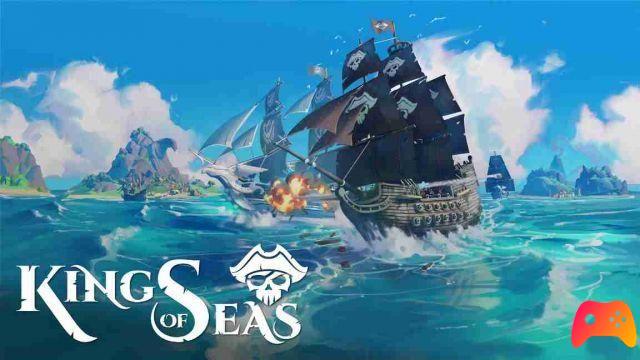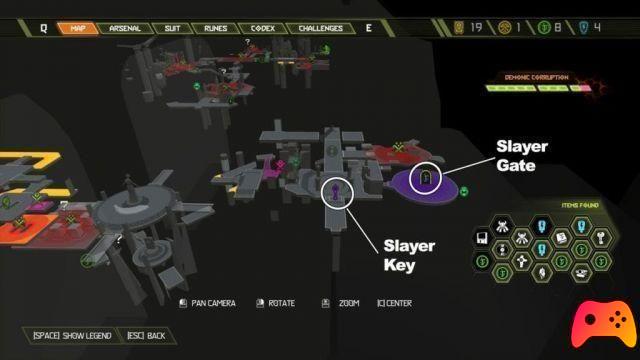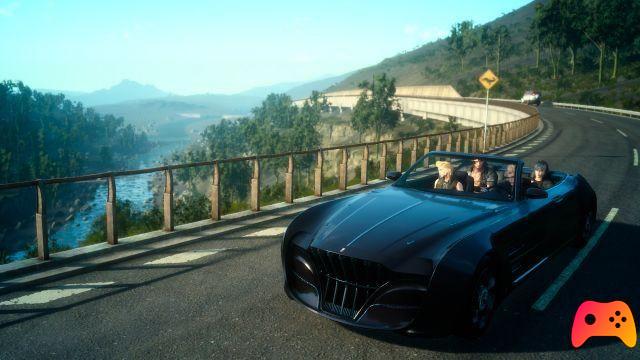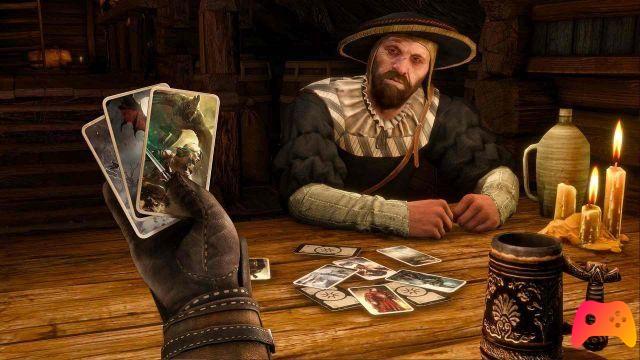
If there's one constant in The Witcher 3 it's Geralt asking anyone who breathes to play Gwent. What is it? Simple, it is the most popular card game on the continent, and being a good player can open doors or flesh out our coffers in ways that few other things can do.
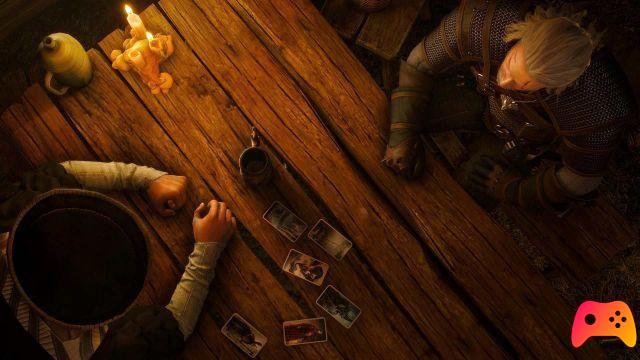
Geralt of Rivia is an avid gamer of Gwent, and soon everyone who plays him on PlayStation 4, Xbox One or Nintendo Switch will become one. The minigame, if we can call it that, was so successful that it spawned one free-to-play spin-off called GWENT: The Witcher Card Game. In this guide we will focus on the original version featured in The Witcher 3, but the basic rules are the same.
The tutorial at the beginning of the game at Bianco Orutteto provides the basics of this card game, but the desire to play and explore is so great that it could be overlooked. For this reason, and also to put it in paper form and be easy to consult, this guide aims to teach how to play Gwent, or at least give a smattering of it, complete with images.
Let's start with the basics: as we said, Gwent is a card game that simulates a clash between 2 armies of the game divided into 3 lines: body to body, ranged combat, harassment. The purpose of the game I say win two rounds against another player, no matter if in a row, having the highest number given by the sum of the units on the field.
The various decks available are:
- Monsters (Red)
- Nilfgaard (black colour)
- Northern Kingdoms (blue color)
- Scoia'teil (green colour)
- Skellige (purple color, added with The Witcher 3: Blood and Wine expansion)
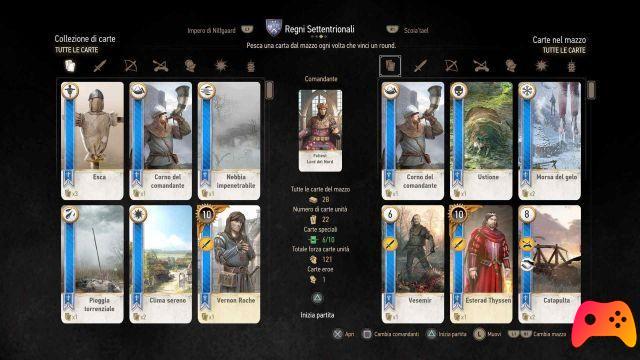
The peculiarity of Gwent is that you can insert as many cards as you like in your deck (as long as you have at least 22 attack units) but, at the same time, once the game has started and the coin has been tossed which decides who goes first, you must play with only the first 10 cards from the beginning to the end of the match. Of course, there is a way to increase the number of cards in your hand, but we'll see that later. At the moment it is enough to know that we will have to play our game with the first 10 cards that chance chooses for us.
In The Witcher 3 you always start the game with a Northern Realms deck. It's a good starting deck, but the other cards will have to be found or won around the Continent, including the "Hero”, Unique and strong cards almost always linked to these. We can say with some conviction, however, that this will be the deck we will end up with even mid-game. To be able to use a deck you need, remember, to have at least 22 attack cards - collecting them is not very fast, being all random, and this explains why it will be difficult to build other decks right away. Where to find the cards in the Witcher 3? Search the inns around the game world. For the more powerful ones, however, it will be necessary to carry out secondary missions.
Each deck has a perk, that is a 'innate ability that snaps during the game. Here are the perks of the individual decks in The Witcher 3:
- Monsters: Keep a random card on the battlefield at the end of each round
- Nilfgaard: Win any round that ends in a tie
- Northern Kingdoms: Draw an additional card at the end of each won round
- Scoia'teil: Decide who starts the game
- Skellige: 2 random cards are moved from the graveyard to the battlefield at the start of the third round
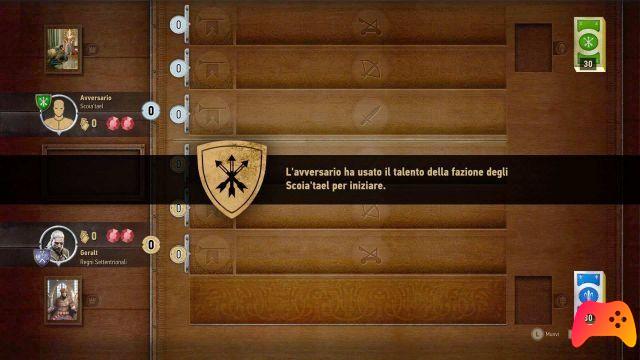
Each deck has its own leader, or commander, each with effects that can change the meaning of a game. Let's see them one by one with some effects with which you can play them, once per match, knowing full well that in The Witcher 3 these have different effects than their counterparts in the dedicated spin-off.
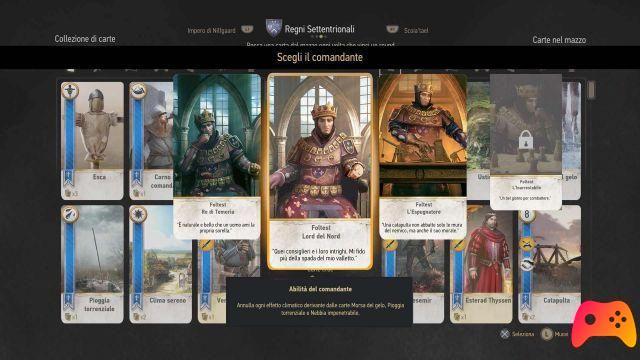
- Monsters: Eredin, Commander of the Wild Hunt (eg Double the strength of one of the three units in the field)
- Nilfgaard: Emhyr Var Emreis, Emperor of Nilfgaard (ex. Draw a Torrential Rain card / Cancel the opposing Leader Ability)
- Northern Kingdoms: Foltest, Lord of the North (ex. Draw Impenetrable Fog card / Cancel the weather effect on the playing field)
- Scoia'teil: Francesca Findabair, Queen of the Elves (ex. Draw an extra card at the start of the game / Draw a Bite of Frost card)
- Skellige: Crach en Craite o Bran Tuirseach (Shuffle the cards in the graveyard into their respective decks / Units hit by a climate card lose half their strength)
Let us now turn to practice: let's play a game!
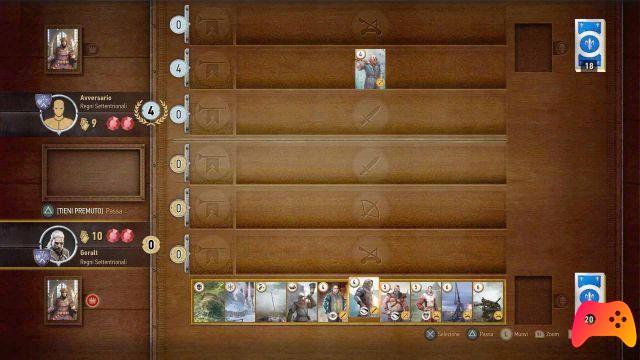
Here's what the playing field looks like. We will always be in the lower part of the battlefield. Near him 2 gems, which symbolize the rounds, and the cards left in hand. The object of the game is to "break" both opposing gems and thus win the game. Once the currency the famous 10 cards will be drawn. Of these, the game always gives a chance to exchange 2 with others from the deck if we do not consider these useful for the victory.
We will soon understand that Gwent is not a mere math game: its most important strategic component is card management, keeping them in view of the possible 3 game rounds. For this purpose it is important to know that the hand can be "passare”By not adding any cards to the battlefield, often to conserve the cards. Once the hand has passed, it will be up to the CPU to decide whether to add cards, if its total is less, or fold too, if its total is greater and win the round.
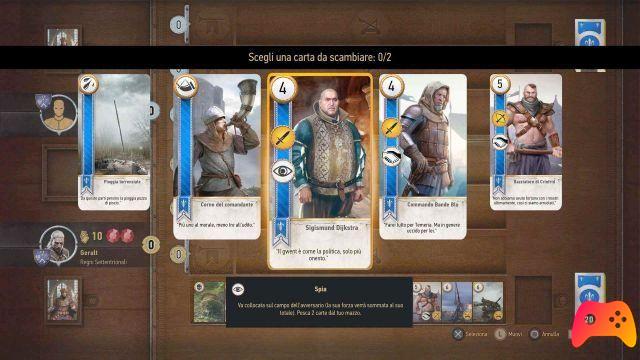
Be that as it may, our guinea pig is an innkeeper from the city of Novigrad who has the same deck as us. She begins, placing her first unit at a distance. At this point, it is necessary to divide the cards in two: attack cards and support cards, which in the image you see without any number and with a design in the upper left corner, such as the horn or the rain. They are cards that produce various effects on the battlefield.
The most important are the climate cards, which add a climate to the battlefield with various effects on both battlefields, so it's best used when you have little or nothing to lose. I'm:
- Grip of frost: lowers the strength of each card in the first row to 1 (melee)
- Impenetrable fog: lowers the strength of each card in the second row to 1 (at a distance)
- Torrential rain: lowers the strength of each card in the third row to 1 (siege)
- Peaceful climate: cancels the effects of previous climate cards
Let's quickly explain i symbols on the different cards, so that the picture game is easier to understand:
Il top left number is strength of that card. The higher the better it is for us, of course. Taking Sigismund Dijkstra's card as an example, its strength is 4. Next, on the colored cloth appears which group he is part of, in this case melee. Dijkstra also has another symbol, an eye: it is one light.
The spy is a particular card, as it is placed on the opponent's battlefield, increasing the total enemy, but giving in exchange the possibility to draw 1 or 2 cards from your deck. At the beginning the only spy you will have at your disposal will be Prince Stannis (5) and you will soon understand that they are among the most precious cards of Gwent and, moreover, absolute protagonists of Gwent at high levels.
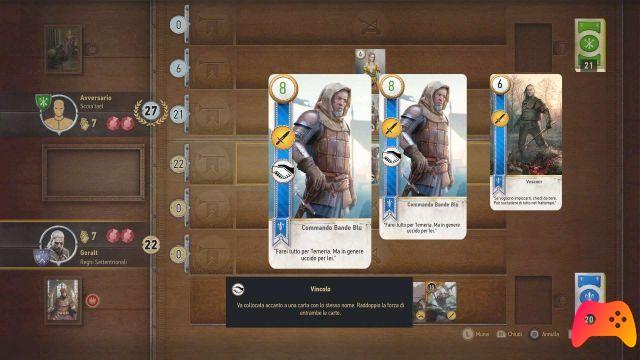
Other symbols can be the handshake or heart, of which we have examples in the image. Respectively, the identical cards with the symbol they give each other strength by doubling their value, while the doctor can resurrect a card from the cemetery. Other symbols may have a cross (increase the unit of the same row by 1) or a elmo (automatically calls the cards with the same name on the field).
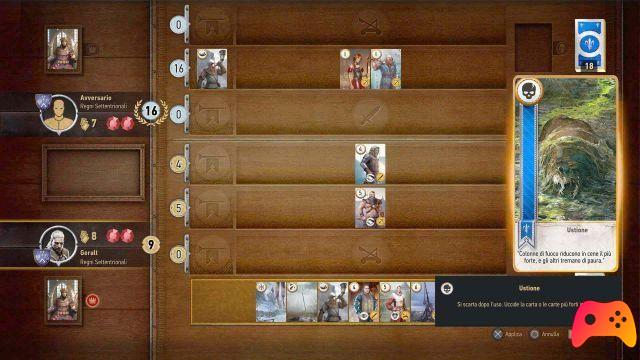
Let's go back to our game: to scrutinize the opponent's intentions and not waste our best cards at the beginning, we first put a 4 card and then 5. The innkeeper raises by adding another 5 card in the remote row and doubling their strength with the card "Battle horn". He invited us to the wedding: in our case we had the card Burn, which destroys the two most powerful cards at that time in any battlefield.
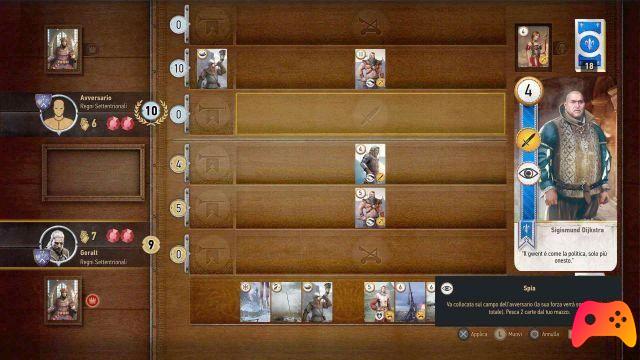
Say goodbye to the two cards, the innkeeper puts in another of 5 which doubles. The only way to take that battle horn off is to move on to the next round. Our cards are not very good and here comes the spy, thanks to which we draw two cards.
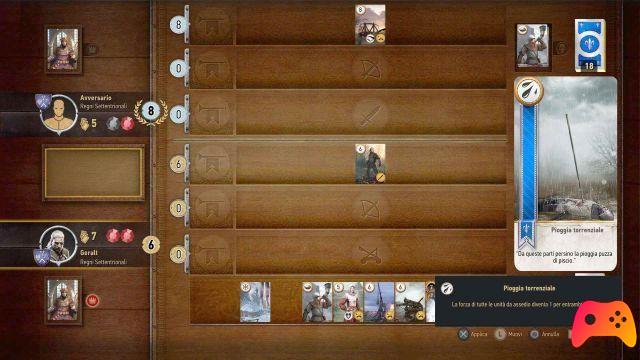
In the next image we have won the first round, and we have 7 cards left against the 5 of the innkeeper. Let's start by fielding Vesemir (6), which we just caught thanks to Dijkstra, while she raises with an 8 Catapult.
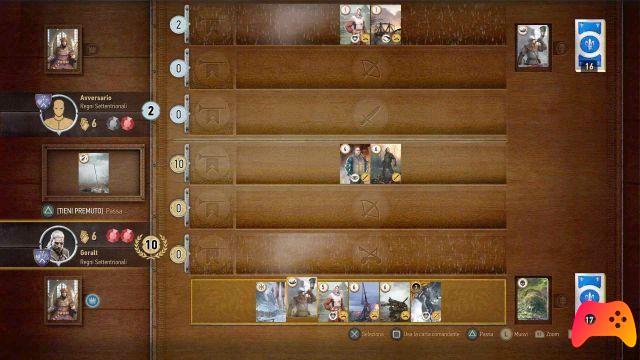
It's the perfect time for a little bit of pioggia, which will lower the massive number of the Catapult to 1. Let's bring torrential rain into action - that means, remember, our camp will also be plagued and we have barred ourselves from using our siege units (for now).
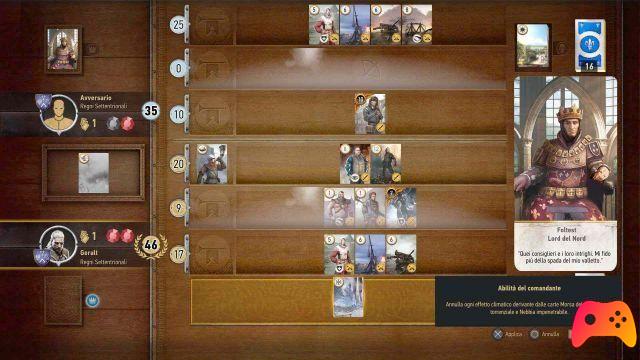
Next image: we are in the final stages of the game. During the game the innkeeper played a Clear Climate, removing the rain, while we all arrows to our bow: the battle horn (kindly given to the girl), which doubled Vesemir and Dijkstra, and other cards we had in hand or we recovered from the cemetery thanks to the two doctors, including Yennefer (cataloged as a hero character, as evidenced by the "sun").
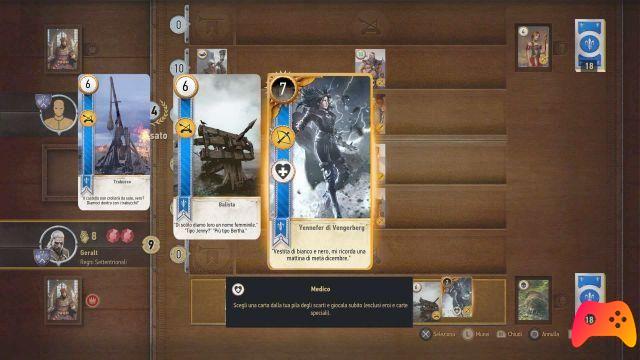
At this point, we just have to use the skill of our commander: an automatic clear climate, to sweep away the fog that afflicts the central line and bringing our total from 46 to 55. Victory!
These are the basics of Gwent. The real skill is to keep the cards and exploit them at the right time: not only to increase the number, but you also have to fight the opponent and play cunning. Furthermore, each faction has its own particularity: for example, the style of play of the deck Monsters is very aggressive, preferring the melee line, while Nilfgaard he bases his game on spies.
Playing Gwent in The Witcher 3 is a good way to raise money and above all increase your card collection, adding more and more possibilities to our arsenal. For any doubt or question, we have the appropriate comments section. Come on: at most we will ask you to play Gwent.
► The Witcher 3: Wild Hunt is an RPG-Action-Adventure game developed by CD Projekt RED and published by Bandai Namco for PC, PlayStation 4, Xbox One and Nintendo Switch, the video game was released on 19/05/2015
The Witcher 3: Wild Hunt is not a game worth buying: we decided to rate it with a %, if you are interested in learning more you can read the Review of The Witcher 3: Wild Hunt




